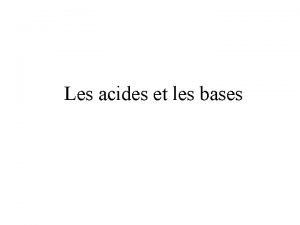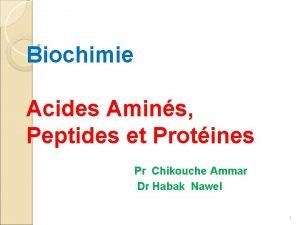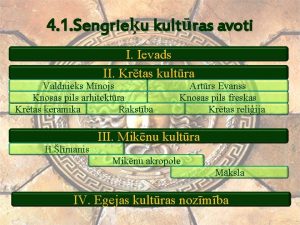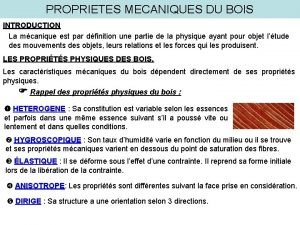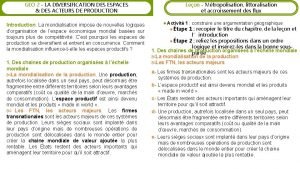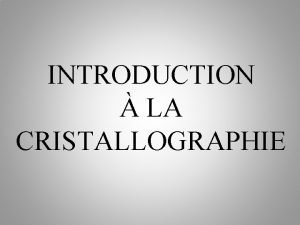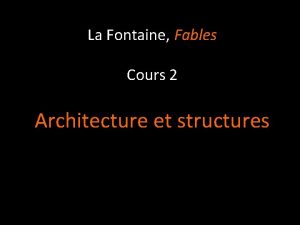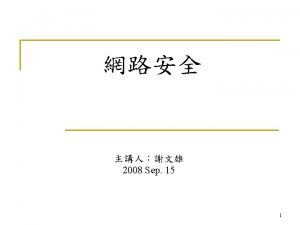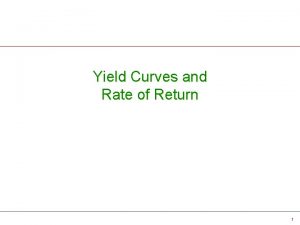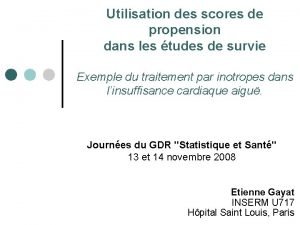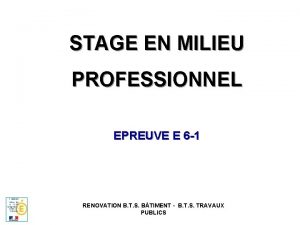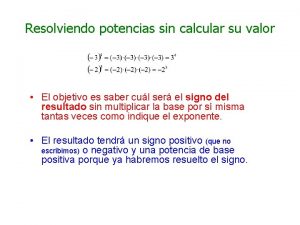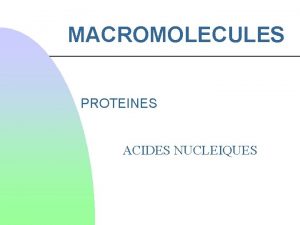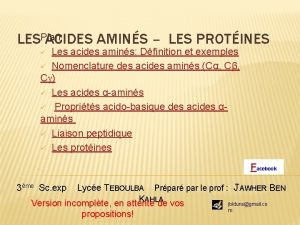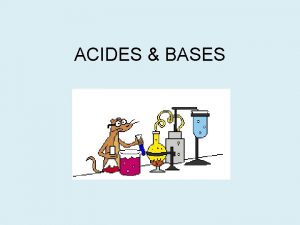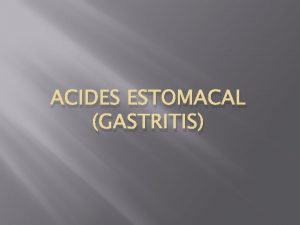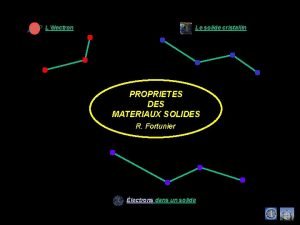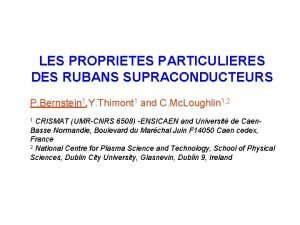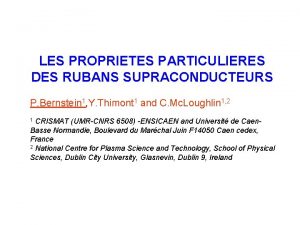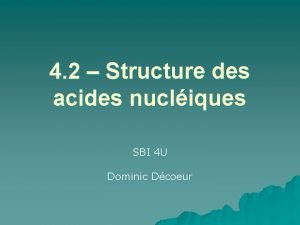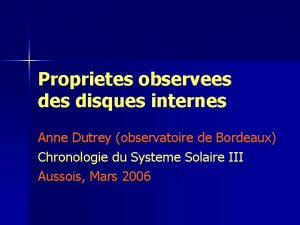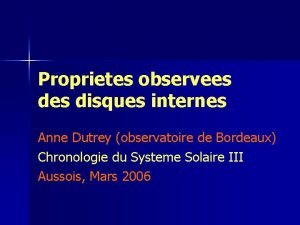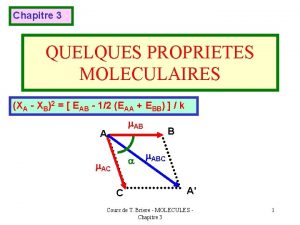STRUCTURE ET PROPRIETES DES ACIDES NUCLEIQUES Prsent par








































- Slides: 40

STRUCTURE ET PROPRIETES DES ACIDES NUCLEIQUES Présenté par Dr E. Feraga Année universitaire 2019/2020

PLAN DU COURS 1. CONSTITUANTS DES ACIDES NUCLÉIQUES 1 -1 - Les pentoses 1 -2 - Les bases azotées 1 -3 - Acides phosphorique 1 -4 - Les nucléosides 1 -5 - Les nucléotides 1 -6 -La chaîne polynucléotide 2. STRUCTUES DES ACIDES NUCLÉIQUES : 2 -1 -L’ACIDES DÉSOXYRIBONUCLÉIQUE (ADN ou DNA) 2 -1 -A-Constitution 2 -1 -B-Localisation 2 -1 -C-Rôle 2 -1 -D-Structure et organisation 2 -2 -L’ACIDE RIBONUCLÉIQUE(ARN ou ARN) 2 -2 -A-Structure 2 -2 -B-Classification 3. PROPRIETES DES ACIDES NUCLÉIQUES 3 -A-PROPRIETES PHYSICO-CHIMIQUES DES ADN 3 -B-PROPRIETES PHYSICO-CHIMIQUES DES ARN

STRUCTUES DES ACIDES NUCLÉIQUES 1. CONSTITUANTS DES ACIDES NUCLÉIQUES 1 -1 - Les pentoses 1 -2 - Les bases azotées 1 -3 - Acides phosphorique 1 -4 - Les nucléosides 1 -5 - Les nucléotides 1 -6 -La chaîne polynucléotide

1 -1 -Les pentoses 1 5 ‘ β D(-)-ribose ARN 2 -désoxy- β D(-) ribose ADN

STRUCTUES DES ACIDES NUCLÉIQUES 1. CONSTITUANTS DES ACIDES NUCLÉIQUES 1 -1 - Les pentoses 1 -2 - Les bases azotées 1 -3 - Acides phosphorique 1 -4 - Les nucléosides 1 -5 - Les nucléotides 1 -6 -La chaîne polynucléotide

1‐ 2‐ Les bases azotées • Hétérocycles aromatiques azotés • Deux familles : Les bases pyrimidiques § Cytosine § Uracile § Thymine Les bases puriques § Adénine § Guanine

1 -2 - Les bases azotées • Les bases pyrimidiques = dérivée de la pyrimidine § Cytosine (C) : 2 hydroxy 4 amino pyrimidine→ ARN , ADN § Uracile (U) : 2‐ 4 dihydroxy pyrimidine →ARN § Thymine (T) : 5 méthyl uracil ou 5 méthyl 2‐ 4 dihydroxy pyrimidine →ADN

1 -2 - Les bases azotées • Les bases puriques = Ny pyrimidine + Ny imidazole § Adénine (A) : 6 amino purine. § Guanine (G ) : 2 amino 6 hydroxy purine

1‐ 2‐ Les bases azotées les formes tautomères des bases p. H 7 céto énol

1 -2 - Les bases azotées • Les bases modifiées bases pyrimidiques modifiés ‐ ADN : la N 5 méthycytosine ‐ ARN : le pseudouracile et dihydrouracile DHU bases puriques modifiés ‐ ADN : la N 6 méthyladénine ‐ ARN : la N 7 méthylguanine et l’hypoxanthine

STRUCTUES DES ACIDES NUCLÉIQUES 1. CONSTITUANTS DES ACIDES NUCLÉIQUES 1 -1 - Les pentoses 1 -2 - Les bases azotées 1 -3 - Acides phosphorique 1 -4 - Les nucléosides 1 -5 - Les nucléotides 1 -6 -La chaîne polynucléotide

1 -3 - Acides phosphorique • Groupement phosphorique H 3 PO 4 • Possède 3 F(X) acides OH (O-) ‐ Formes ionisées ≈ p. H 1/2.

STRUCTUES DES ACIDES NUCLÉIQUES 1. CONSTITUANTS DES ACIDES NUCLÉIQUES 1 -1 - Les pentoses 1 -2 - Les bases azotées 1 -3 - Acides phosphorique 1 -4 - Les nucléosides 1 -5 - Les nucléotides 1 -6 -La chaîne polynucléotide

1 -4 - Les nucléosides NUCLÉOSIDE = OSE + BASE 2 -désoxy- β D(-) ribose β D(-)-Ribose Pyrimidique Purique

1 -4 - Les nucléosides b. Base purique Base pyrimidique N glycosidique Adénine+β D(-)-ribose =Adénosine Thymine +2 -désoxy- β D(-) ribose = 2’-désoxy. Thymidine

La nomenclature des nucléosides

STRUCTUES DES ACIDES NUCLÉIQUES 1. CONSTITUANTS DES ACIDES NUCLÉIQUES 1 -1 - Les pentoses 1 -2 - Les bases azotées 1 -3 - Acides phosphorique 1 -4 - Les nucléosides 1 -5 - Les nucléotides 1 -6 -La chaîne polynucléotide

1 -5 - Les nucléotides NUCLÉOTIDEDE = OSE + BASE + Gp P β D(-)-Ribose 2 -désoxy- β D(-) ribose Pyrimidique Purique 1 Gp P → nucléotide monophosphate 2 Gp P → nucléotide diphosphate 3 Gp P →nucléotide triphosphate NUCLÉOTIDE = NUCLÉOSIDE + Gp P

1 -5 -A- Les nucléotides monophosphates Liaison ester Liaison phosphoester 5’

La nomenclature des nucléotides monophosphate AUTRE: § Purines : suffixe en "ylique" Exp : acide adénylique ou (AMP) § Pyrimidine: suffixe en "idylique" Exp : acide thymidylique ou (TMP)

1 -5 -A- Les nucléotides monophosphates UNITÉ STRUCTURALE DES ACIDES NUCLÉIQUES

1 -5 -B- Les nucléotides diphosphates Les nucléotides triphosphates Liaison phosphoanhydride β α v La nomenclature nucléotide diphosphate , triphosphate: ‐diphosphate + la nomenclature nucléotide ‐triphosphate + la nomenclature nucléotide

1 -5 -B- Les nucléotides diphosphates Les nucléotides triphosphates • Rôles: § composants de coenzymes (NAD, NADP, FAD. . . ) § rôle métabolique § rôle exégétique: liaison phosphoanhydride entre Pβ et Pγ , Exp : l'ATP

STRUCTUES DES ACIDES NUCLÉIQUES 1. CONSTITUANTS DES ACIDES NUCLÉIQUES 1 -1 - Les pentoses 1 -2 - Les bases azotées 1 -3 - Acides phosphorique 1 -4 - Les nucléosides 1 -5 - Les nucléotides 1 -6 -La chaîne polynucléotide

1 -6 -La chaîne polynucléotide 2 nucléotides monophosphates 3’ 5’ Liaison ester Liaison phosphodiester

1 -6 -La chaîne polynucléotide

1 -6 -La chaîne polynucléotide Partie variable Partie constante

1 -6 -La chaîne polynucléotide Représentations: 5' C—A— G—T —G—T 3' Sucre

ACIDES NUCLÉIQUES Polynucléotides Bases Sucres Groupement phosphate ADN A, T, C, G désoxyribose 1 ARN A, U, C, G ribose 1

STRUCTUES DES ACIDES NUCLÉIQUES 2. STRUCTUES DES ACIDES NUCLÉIQUES : 2 -1 -L’ACIDES DÉSOXYRIBONUCLÉIQUE (ADN ou DNA) 2 -1 -A-Constitution 2 -1 -B-Localisation 2 -1 -C-Rôle 2 -1 -D-Structure et organisation 2 -2 -L’ACIDE RIBONUCLÉIQUE(ARN ou RNA) 2 -2 -A-Structure 2 -2 -B-Classification ( ≠ types d’ARN)

STRUCTUES DES ACIDES NUCLÉIQUES 2. STRUCTUES DES ACIDES NUCLÉIQUES : 2 -1 -L’ACIDES DÉSOXYRIBONUCLÉIQUE (ADN ou DNA) 2 -1 -A-Constitution 2 -1 -B-Localisation 2 -1 -C-Rôle 2 -1 -D-Structure et organisation 2 -2 -L’ACIDE RIBONUCLÉIQUE(ARN ou RNA) 2 -2 -A-Structure 2 -2 -B-Classification ( ≠ types d’ARN)

2 -1 -L’ACIDES DÉSOXYRIBONUCLÉIQUE ADN Partie protéique • Pr- basiques (histones + protamines) • Pr- non basiques. CONSTITUTION Partie non protéique • Acide nucléique ADN (polynucléotides)

2 -1 -L’ACIDES DÉSOXYRIBONUCLÉIQUE ADN Localisation Eucaryote → Ny +Mito , chloroplastes Procaryote → Cyt

2 -1 -L’ACIDES DÉSOXYRIBONUCLÉIQUE ADN • Rôle : – support et stockage de l’information génétique organisme – $ Pr‐ + régulation $ – l'hérédité

2 -1 -L’ACIDES DÉSOXYRIBONUCLÉIQUE ADN STRUCTURE ORGANISATION ADN eucaryote ADN nucléaire Structure IIaire Structure IIIaire ADN mitochondrial ADN nucléaire procaryote

2 -1 -L’ACIDES DÉSOXYRIBONUCLÉIQUE ADN Structure primaire § Polynucléotide: bicaténaire=doublele brin+++ § Répétition : Ntide monophosphate = Unité monomérique GMP, AMP, TMP, CMP § Liaisons phosphodiester : C 3’ 1 er. Ntide↔C 5’Ntide adjacent § Sens d’un brin d’ADN: 5’P→ 3’ OH libre

2 -1 -L’ACIDES DÉSOXYRIBONUCLÉIQUE ADN STRUCTURE ORGANISATION ADN nucléaire eucaryote ADN nucléaire procaryote Structure Iaire Structure Iiaire: Double hélice Structure IIIaire ADN mitochondrial

2 -1 -L’ACIDES DÉSOXYRIBONUCLÉIQUE ADN v. Antiparallèles

2 -1 -L’ACIDES DÉSOXYRIBONUCLÉIQUE ADN v. Complémentaire Equimolaire G=C A=T

2 -1 -L’ACIDES DÉSOXYRIBONUCLÉIQUE ADN Structure secondaire v Hélicoïdale 10 pb § § § § § Droite Régulière 1 tour ≈ 10 pb = 34 nm ᴓ 2 nm 2 squelettes P-S Ext Bases Int ┴ axe Bases planes //Bases : D 3, 4 nm 2 sillons largeurs ≠ stabilisée / ‒ liaisons H ‒ transfert de charge Modèle de James Watson et Francis Crick et Maurice wilkins, 1953
 Acide conjugué
Acide conjugué Dissociation des acides aminés
Dissociation des acides aminés Dangerosité des solutions acides et basiques
Dangerosité des solutions acides et basiques Des des des
Des des des Simple prsent
Simple prsent Prsent simple tense
Prsent simple tense Prsent continuous
Prsent continuous Prsent simple
Prsent simple Former le conditionnel
Former le conditionnel Par knosas pili stāsta mīts par
Par knosas pili stāsta mīts par Cisaillement bois
Cisaillement bois Fonction valeur absolue forme canonique
Fonction valeur absolue forme canonique Rationaliser le dénominateur
Rationaliser le dénominateur L'empire vpn construit par des agents de renseignements
L'empire vpn construit par des agents de renseignements La diffusion des idées des lumières
La diffusion des idées des lumières Il existe des personnes qui sont des lumières pour tous
Il existe des personnes qui sont des lumières pour tous Temps verbaux et leurs valeurs
Temps verbaux et leurs valeurs Affiche de propagande plan marshall
Affiche de propagande plan marshall Diversification des espaces et des acteurs de la production
Diversification des espaces et des acteurs de la production Le volume d'un corps
Le volume d'un corps Volume des liquides et des solides
Volume des liquides et des solides Cartographie des flux de valeur
Cartographie des flux de valeur Je t'offrirai des fleurs et des nappes en couleurs
Je t'offrirai des fleurs et des nappes en couleurs Robin des bois des alpes
Robin des bois des alpes Double des and triple des
Double des and triple des Budget des ventes
Budget des ventes Volume d'un hexagonal compact
Volume d'un hexagonal compact Structure des opportunités politiques
Structure des opportunités politiques Structure d'une fable de la fontaine
Structure d'une fable de la fontaine Transposition ciphers
Transposition ciphers Structure des ordinateur
Structure des ordinateur Par curve
Par curve Méthode d'appariement par score de propension
Méthode d'appariement par score de propension Fracture bimalléolaire sus tuberculaire
Fracture bimalléolaire sus tuberculaire Par nepar igra
Par nepar igra Exemple appréciation stagiaire
Exemple appréciation stagiaire Recherche inversée par image
Recherche inversée par image Vieillissement par le bas
Vieillissement par le bas La route de chlifa résumé
La route de chlifa résumé Fraccion negativa con exponente impar
Fraccion negativa con exponente impar Par oxidação redução
Par oxidação redução
